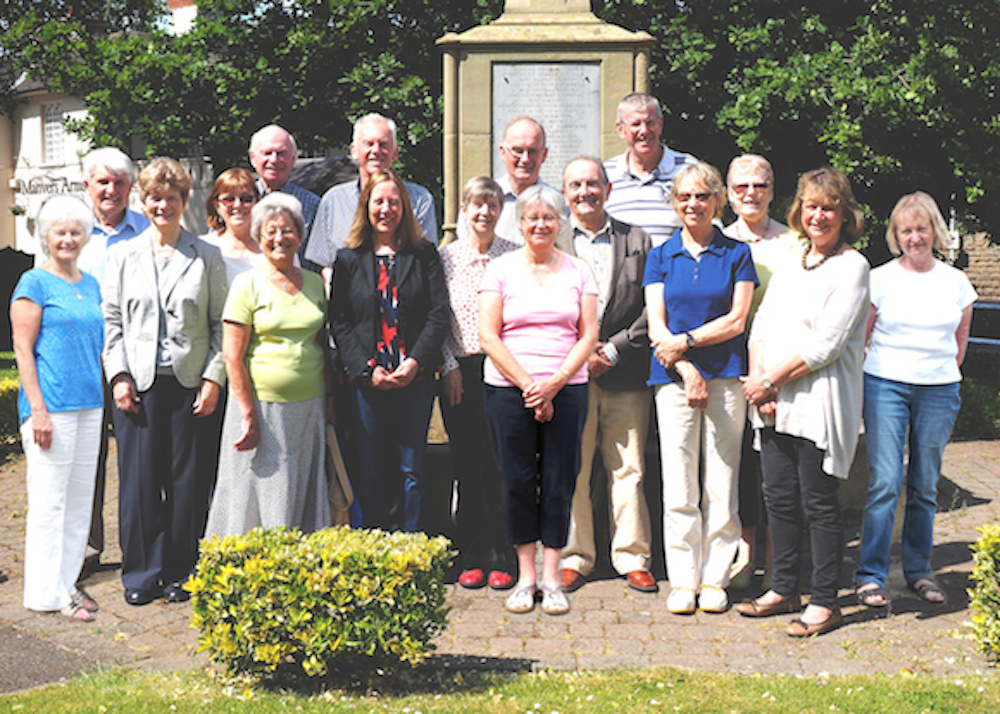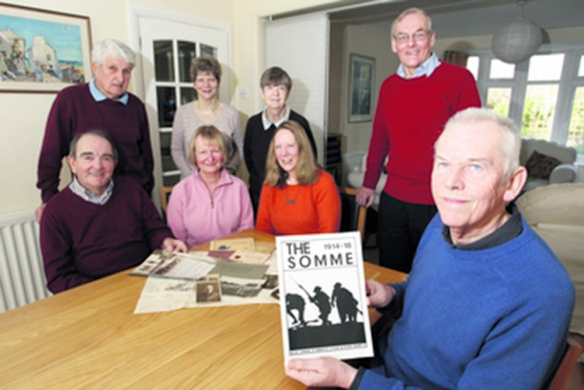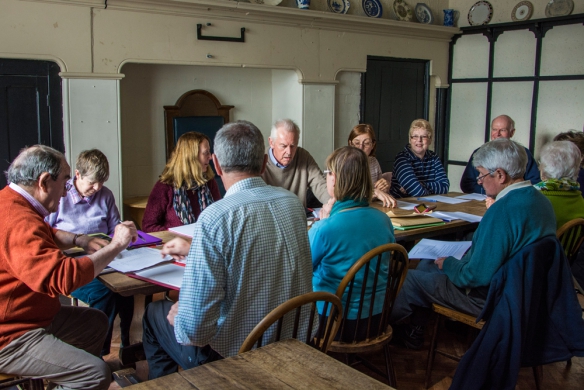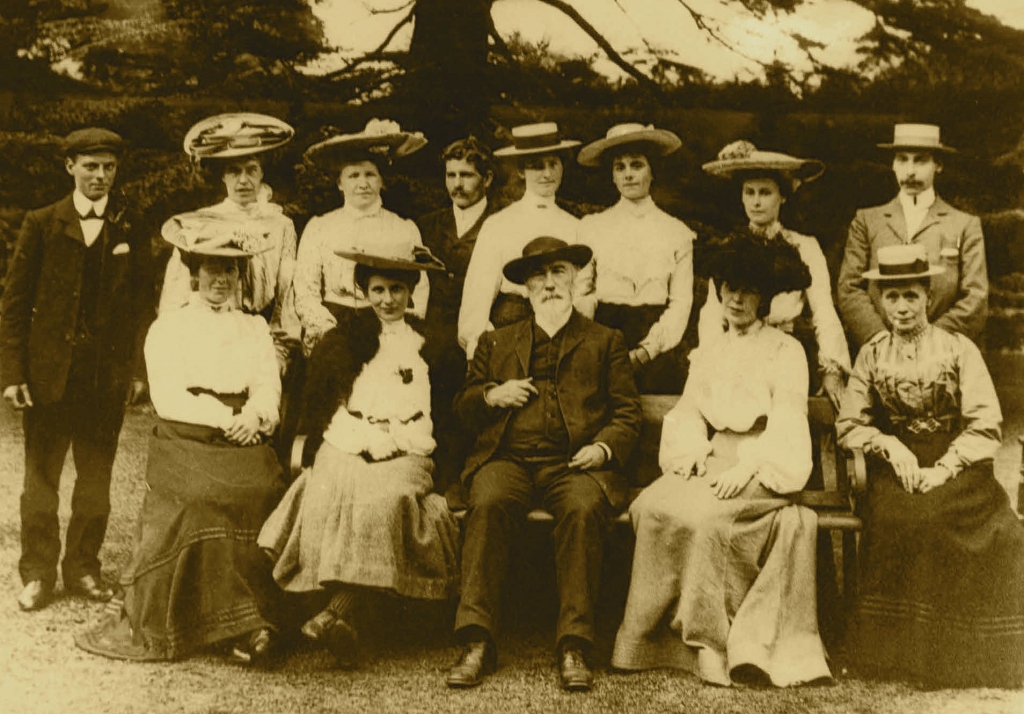Radcliffe on Trent U3A WWI Exhibition Project Team

Back row from left: John Toon, Dave Barton, Philip James, Jim Parkhouse
Front Row from left: Jill Palfreman, John Parry, Pauline Woodhouse, Christine Bland, Barbara Sawford, Rosie Collins, Diana Barrett, Philippa Culshaw, Stan Harbidge, Mary Riddell, Lyn Toon, Diane Kidger, Marion Caunt.
Hello!
We’re the University of the Third Age (U3A) Radcliffe WW1 exhibition project team from Radcliffe on Trent, a large village in the Rushcliffe borough of Nottinghamshire. Our project commemorated the centenary of the First World War by holding a major exhibition in August 2014. We were funded by the Heritage Lottery Fund, Radcliffe on Trent Parish Council, Rushcliffe Borough Council and Nottinghamshire County Council and thank them for their support. Since 2014 the research on the impact of the war on Radcliffe on Trent has been continued by Diana Barrett, Marion Caunt, Rosie Collins and Pauline Wodehouse who have built this website and produced its content. Click here to read more about them.
Why we joined the Radcliffe on Trent WWI project
Dave: I first had the idea for researching the stories of those named on Radcliffe on Trent’s War Memorial as the hundredth anniversary of the outbreak of the First World War approached. I realised that within the ranks of Radcliffe U3A there would be others who would share this interest. Very soon we decided that the ideal way to present our findings would be to stage an exhibition in the village in August 2014 and so we set to work.
Rosie: The U3A project was an opportunity to use my research background to explore the impact of WWI on the village where I live. We soon moved beyond researching the names on the memorial. Working on the project encouraged us to discover as many local servicemen as possible and produce a permanent record of those who served. Our Roll of Honour listing previously unrecorded servicemen from Radcliffe on Trent is a major achievement of the research. Some of us have written individual biographies of 400 servicemen on the roll of honour, showing their association with the village and what happened to them during and after the war. Their often harrowing stories form part of the wider narrative of the impact of WWI on individuals, communities and nations
Marion: Having read extensively about the conflict, I felt that it was necessary to keep the memory of this terrible episode in our history alive for future generations. I have found the research into the soldiers’ lives absolutely fascinating and as a local historian being able to relate the conflict to the everyday lives of the village of Radcliffe on Trent has been most rewarding.
Pauline: My grandfather’s brother, Horace Smith, served with the Sherwood Foresters and was killed at Passchendaele. My grandmother was a VAD in Radcliffe. Since becoming involved in the project I’ve become very interested in researching the part played by women in WWI and have written several local women’s biographies.
Diana: My father Samuel Pike, killed in WWII and my great uncle Charles Wightman Pike, killed in WWI, are remembered on the Radcliffe on Trent Memorial. The effect on my family of both those losses was considerable. Brielen is a village in Belgium, north-west of Ypres, where there is a WWI cemetery; it was also the name of my family home in Radcliffe. I cannot remember when I wasn’t aware of its significance as that house was my grandfather’s personal memorial to his brother, Charles, who was killed in October 1917 and interred at Solferino Farm, Brielen. Those who were killed are remembered but those who were affected by the war in so many different ways, less so. The memories were so painful that a generation was unaware of the part their family played in the Great War. A chapter in my family history has now been written. Hopefully our research has done the same for other families linked to Radcliffe on Trent. A lasting memorial to all those who served, not just those who lost their lives, was important to me. I am proud to have played a part in creating it.

From left, standing: John Parry, Pauline, Diana, Bob. Seated from left: Stan, Marion, Rosie, Dave
Image credit: Newark Advertiser
Christine: My main reason for joining the project was to find out more about the effect the war had on the lives of people in the village, especially as some of my relatives were living in the village at that time.
Philippa: I thought it would be interesting to find out more about Radcliffe where I have lived for 33 years and where my children have very strong roots.
Stan: Ever since I saw the original version of “All Quiet on the Western Front” many years ago, I have always had a wish to know more about the causes and the after effects of this terrible war. Even after so many years of reading about and hearing of events during the war it still angers and upsets me at the apparent futility of it all.
Philip: I used to question my maternal grandfather, who fought on the Western Front, about his experiences. He would start to reply but before long would say “you wouldn’t understand” and that is as much as I could get out of him. I therefore wanted to find out more of what he had experienced and so joined the group.
Diane: My interest in WWI goes back many years. I have a piece of Trench Art – a chunk of Ypres cathedral bell mounted on a plinth with a plaque – which was made by my husband’s grandfather Charles Kidger, born in 1877. He served in the Royal Field Artillery with the Lahore Division on the Western Front. Having the fragment of the bell in my home helps me feel connected to the First World War.
Jim: I had some military experience in the CCF at school and serving four years in the local Territorial Army, my interest was sparked in the camaraderie this experience produced. Two battlefield explorations to France and Belgium pointed this interest towards WW1 so when the opportunity arose to help with the Radcliffe WW1 project, I joined to find a similar attention and drive from the other members of the group.
John P: I’ve always been interested in social history and became inspired by the bravery, courage, good humour and discipline shown by the troops in the face of the appalling losses in the trenches in WWI. So I jumped at the chance to join the U3A Group.
Jill: With all the information that has come to light, I can now understand the impact the war had upon the local families and the village. The names of the men on the war memorial have become “real” as I have learnt about them and their families.
Mary: My motivation was curiosity about local history, having so recently moved to Radcliffe on Trent.
Barbara: My grandfather lived in Nottingham and fought with the Sherwood Foresters. I’ve always been interested in history and the U3A project was a good way to find out about Sherwood Foresters from our village.
John T: Born and bred in Radcliffe on Trent, I was able to trace my family back to at least my great-great-grandfather. I found out about my grandfather, George Toon, who was injured in France in 1917.
Lyn: The project spurred me on to find out about my grandfather, who was from Nottingham; he fought in World War 1.

Group meeting in 2014 at the Royal British Legion
From left: Stan, Diana, Rosie, Dave, Christine, Lyn, John Toon, Diane (hidden) Phillipa (hidden), Jill, John Parry, Marion, Jim
Special thanks
The group received a civic award from Radcliffe on Trent Parish Council. Click here to read more.
The following people made a significant contribution to the success of the project:
Diana Barrett, Marion Caunt, Rosie Collins and Pauline Woodhouse who were closely involved with the exhibition and have since become the research and website team continuing the work of the project.
Dave Barton, the exhibition project co-ordinator. Dave had the original idea for an exhibition when he was Chair of the Radcliffe on Trent U3A and brought together a group of U3A volunteers to make it happen. He inspired and motivated the team, raised funds and co-ordinated work for the exhibition. He has since become a member of Radcliffe on Trent Parish Council.
Nigel Cook, graphic designer. Nigel designed the logo, publicity material, exhibition posters and our book Radcliffe Remembers: Radcliffe on Trent and the First World War’. His unique branding allows the project to stand out.
Richard Caunt, photographer. Richard has produced a photographic record of the project tracing its development since 2013. He digitalised the Cutler collection of early twentieth century photos of Radcliffe people, many of which we have used in our documents.
Click on the highlighted names under the photo from the Cutler collection below to find out what happened to them in WWI.

